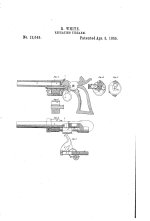Gaucho Gringo
New member
The Roland White patent covered a bored straight through chamber in which the metallic cartridge is loaded through the rear. The chamber on a teat fire is not bored all the way through and it loads from the front, thus getting around the patent. Colt circumvented White's patent with it's Thuer conversions which although were bored through were tapered and also loaded from the front. It is interesting the ingenuity of all the gun manufacturers in the mid to late 1800's and that most of their designs are still usable today.


